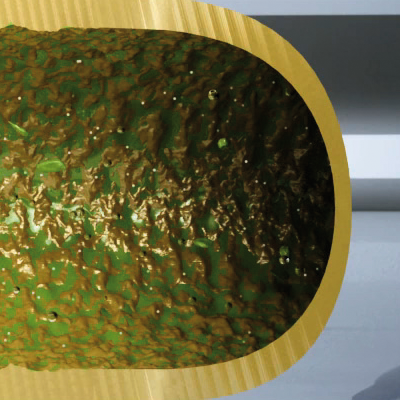
France, Germany and the United Kingdom each has their own specific regulatory requirements for monitoring bacteria in water systems, and each has their own response to contamination by Legionella and Pseudomonas.
DELABIE offers a range of products that are compatible with these regulations.
Copper, C-PVC, stainless steel, polypropylene… , regardless of the material that the taps and pipework are made from, a biofilm will form inevitably in any healthcare facility after several weeks or months of operation. Pathogenic bacteria are released every time a tap is turned on. In the UK there are 300,000 nosocomial infections a year, and in France waterborne infections account for one third of all nosocomial infections (700,000 cases per year, of which 4,000 are fatal).
Even if it is impossible to eradicate, the biofilm must be controlled. In Europe, many of the 37,000 annual deaths due to hospital acquired infection are attributed to Legionella pneumophila and Pseudomonas aeruginosa.
Different monitoring policies
The regulations regarding hygiene for water systems in healthcare facilities, and in public buildings more generally, vary by country.
Each country has a legal obligation to safeguard the bacteriological quality of water in the system by regular monitoring, sampling and analysis. However, the methods, and subsequent follow-up action, differ.
In France, the Directive dated 30th November, 2005, sets minimum temperatures for hot water in the system to reduce the risk of Legionella development.
These bacteria are the focus of all the attention, via the Directive dated the 1st February, 2010 which provides three levels of monitoring and sampling protocols. Since the 1st January, 2012, compulsory monitoring has been extended to all public buildings.
Germany has adopted the same threshold levels as France, while the United Kingdom is stricter: it conducts additional testing at levels over 100 Colony Forming Units per litre (CFU/L) and initiates curative procedures above 1,000 CFU/L.

Pseudomonas, tracked by the British
The Department of Health (DoH), the Ministerial Department responsible for health in the United Kingdom has addressed the issue of tap and water system contamination by Pseudomonas aeruginosa. Neither France nor Germany has introduced specific protocols to monitor for Pseudomonas, even though it is considered the second largest cause of fatal nosocomial infections.
The Health Technical Memorandum (HTM 04-01) updated in 2016, provides guidance on good practice for monitoring and testing for these two pathogens and identifying the level of contamination in the water.
For Pseudomonas, action is initiated as soon as the alert level is reached, that is to say above 1 CFU/100ml. Remember that this bacteria, which colonises the system from the interior of tap/mixer spouts, rapidly becomes entrenched.
Tailor-made solutions
Removable…
Among the preventive measures recommended, the DoH guidance suggests using mixers and taps that can be easily removed for regular internal cleaning and de-scaling; mechanical interventions that are effective in removing biofilm.
Flushing…
The regulations for the three afore-mentioned countries identify water stagnation in taps, showers and WCs as a factor which favours bacterial contamination. To avoid using stagnant water from the first draw-off, and to assist with water turnover, water controls with an automatic duty flush are recommended.
Moreover, the German Trinkwasser Directive of April 2013, is the only one to require pipework and storage tanks to be drained after 72 hours of stagnation. One solution is to minimise water storage as far as possible - the DoH recommends managing the storage capacity so that reasonable turnover is achieved.
Undersized pipework...
Another unique aspect of the German regulations is that oversized pipes are strictly prohibited because they promote bacterial growth by reducing the water velocity.
DELABIE, along the same lines, recommends slightly decreasing the diameter of the pipes to increase the water velocity to 2m/sec. (likewise in France, the DTU recommends 1.5m/sec.).
Without increasing noise levels, this measure prevents the excessive development of biofilm and helps to reduce the risk of contamination.
Training
Understanding the problems associated with bacterial growth in water systems helps to limit the risk of contamination.
Although French legislators have not yet focused on training those responsible for the water system, it is embedded and pursued in Germany (with three training levels, depending on the level of responsibility) and in the United Kingdom (with personnel competency and training programmes monitored and assessed by the Water Safety Group).
Depending on its history and culture, each country has developed, and is pursuing, a strategy of prevention and control that is more or less binding.
It is clear that without necessarily copying everything from their neighbours’ strategies, the French legislators may need to review their guidance.
Suitable products
DELABIE is particularly concerned with the fight and prevention of bacterial growth and is constantly developing new products to combat it.
The BIOCLIP range of mixers and taps can be removed to enable deep cleaning and the elimination of biofilm present in the tap.
DELABIE’s BIOSAFE electronic mixers and taps, with a duty flush every 24 hours, guarantee complete renewal of water in all their internal parts.
By removing toilet cisterns, DELABIE’s direct flush WC valves eliminate the risk of stagnation.
The solution of smaller diameter pipes is well suited to the low water consumption mixers/taps developed by DELABIE.


